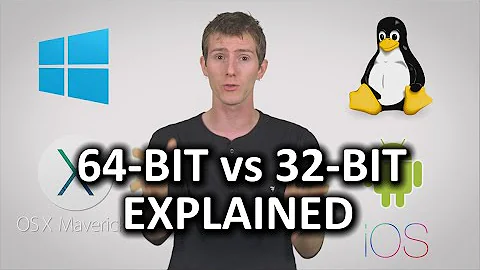What`s the difference between Intel 64 and AMD64?
Solution 1
From what I've read extended Memory 64-bit Technology (EM64T) is Intel‘s implementation of AMD‘s AMD64 and the differences between the Intel64 and AMD64 are:
EM64T’s BSF and BSR instructions act differently when the source is 0 and the operand size is 32 bits. The processor sets the zero flag and leaves the upper 32 bits of the destination undefined.
AMD64 supports 3DNow! instructions. This includes prefetch with the opcode 0x0F 0x0D and PREFETCHW, which are useful for hiding memory latency.
EM64T lacks the ability to save and restore a reduced (and thus faster) version of the floating-point state (involving the FXSAVE and FXRSTOR instructions).
EM64T lacks some model-specific registers that are considered architectural to AMD64. These include SYSCFG, TOP_MEM, and TOP_MEM2.
EM64T supports microcode update as in 32-bit mode, whereas AMD64 processors use a different microcode update format and control MSRs.
EM64T’s CPUID instruction is very vendor-specific, as is normal for x86-style processors.
EM64T supports the MONITOR and MWAIT instructions, used by operating systems to better deal with Hyper-threading.
AMD64 systems allow the use of the AGP aperture as an IO-MMU. Operating systems can take advantage of this to let normal PCI devices DMA to memory above 4 GiB. EM64T systems require the use of bounce buffers, which are slower.
SYSCALL and SYSRET are also only supported in IA-32e mode (not in compatibility mode) on EM64T. SYSENTER and SYSEXIT are supported in both modes.
Near branches with the 0×66 (operand size) prefix behave differently. One type of CPU clears only the top 32 bits, while the other type clears the top 48 bits.
Solution 2
At Wikipedia's x86 page you can read
In 1999-2003, AMD extended this 32-bit architecture to 64 bits and referred to it as x86-64 in early documents and later as AMD64. Intel soon adopted AMD's architectural extensions under the name IA-32e which was later renamed EM64T and finally Intel 64.
In other words, the differentiator is mainly marketing. There are Intel- and AMD specific extensions to the instruction set, but as long as you're writing programs in user space, you don't generally need to know the difference.
Related videos on Youtube
Mayhem
Updated on September 18, 2022Comments
-
Mayhem over 1 year
Can someone explain if there is any difference between the intel64 and amd64 architectures?
-
 Tamara Wijsman over 12 yearsWhere did you read that text from?
Tamara Wijsman over 12 yearsWhere did you read that text from? -
Mayhem over 12 yearsWell, some forums/blogs + wikipedia (en.wikipedia.org/wiki/EMT64#Intel_64). Also I looked over some manuals from Intel and AMD.
-
user2284570 over 7 years
you don't generally need to know the differenceWrong : even minor difference on generic instructions are very important bugs.chromium.org/p/nativeclient/issues/detail?id=2010 -
user2284570 over 7 years@Nubok : Please add the difference for the via technologies‘s implementation of the architecture (64 bit version of course) !
-
Eric W over 5 yearsWrong : even minor difference on generic instructions are very important To be fair, (1), he said you don't generally need to know these differences. Obviously there are specific cases where it can matter. (2) most of us aren't writing a hardened sandbox that must protect any and all available instruction paths.
-
GreenReaper over 5 yearsThe IO-MMU is a big deal - lacking it means you have to soak up a non-trivial amount of low memory for the buffering (64MB is the current default on Linux). Intel later introduced something similar as VT-d and used it for an annoying level of product segmentation - however the reliability of the code (and in some cases the silicon) have tended to result in it not being used by default on Linux for the original purposes.




